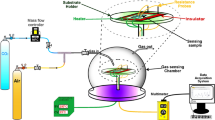Abstract
Tungsten oxide (WO3) was deposited through the successive ionic layer adsorption reaction (SILAR) method at low temperature. The polycrystalline monoclinic structure of deposited WO3 is confirmed by its x-ray diffraction (XRD) pattern. Sensing studies revealed that the nanostructured WO3 has a good response towards formaldehyde (HCHO) at 350°C. A response time of 28 s was observed for 5 ppm HCHO. Density functional theory (DFT) studies were performed to understand the detection mechanism based on the lattice plane growth orientation. The electronic properties of the WO3 were analyzed using the density of states (DOS) and Mulliken population analysis for adsorption of oxygen and HCHO on the WO3 surface. A significant change in the Fermi energy was observed during oxygen and HCHO adsorption on the surface of WO3. The computational results were compared with the proposed HCHO detection mechanism. The results obtained through the present work highlight the possibilities of developing a sensor to detect HCHO concentrations at the ppm level.










Similar content being viewed by others
References
M. Kumar, V. Bhatt, A.C. Abhyankar, J. Kim, A. Kumar, S.H. Patil, and J.H. Yun, Sci. Rep. 8, 1 (2018).
T. Tharsika, M. Thanihaichelvan, A.S.M.A. Haseeb, and S.A. Akbar, Front. Mater. 6, 1 (2019).
M. Poloju, N. Jayababu, and M.V.R. Reddy, Mater. Sci. Eng. B 227, 61 (2018).
J. Zhang, D. Leng, L. Zhang, G. Li, F. Ma, J. Gao, H. Lu, and B. Zhu, J. Alloys Compd. 853, 157339 (2021).
D. Xue, P. Wang, Z. Zhang, and Y. Wang, Sensors Actuators B Chem. 296, 126710 (2019).
S.B. Upadhyay, and P.P. Sahay, NANO 10, 1550113 (2015).
R. Yoo, A.T. Güntner, Y. Park, H.J. Rim, H.S. Lee, and W. Lee, Sensors Actuators B Chem. 283, 107 (2019).
A. Mirzaei, S.G. Leonardi, and G. Neri, Ceram. Int. 42, 15119 (2016).
Y.F. Sun, S.B. Liu, F.L. Meng, J.Y. Liu, Z. Jin, L.T. Kong, and J.H. Liu, Sensors 12, 2610 (2012).
J.C. Murillo-Sierra, A. Hernández-Ramírez, L. Hinojosa-Reyes, and J.L. Guzmán-Mar, Chem. Eng. J. Adv. 5, 100070 (2021).
T. Salthammer, S. Mentese, and R. Marutzky, Chem. Rev. 110, 2536 (2010).
OSHA, Title 29. Chapter XVII. Part 1910.1048. Formaldehyde, Osha 1 (2003).
D. Sun, Y. Le, C. Jiang, and B. Cheng, Appl. Surf. Sci. 441, 429 (2018).
T.A. Nguyen, T.S. Jun, M. Rashid, and Y.S. Kim, Mater. Lett. 65, 2823 (2011).
A. Arfaoui, S. Touihri, A. Mhamdi, A. Labidi, and T. Manoubi, Appl. Surf. Sci. 357, 1089 (2015).
J.W. Geng, Y.J. Ye, D. Guo, and X.X. Liu, J. Power Sources 342, 980 (2017).
R. Gakhar, and D. Chidambaram, Sol. Energy Mater. Sol. Cells 144, 707 (2016).
R. Jain, Y. Lei, and R. Maric, Sensors Actuators B Chem. 236, 163 (2016).
N.A.A.A.R.K. Kampara, P.K. Rai, and B.G. Jeyaprakash, Sensors Actuators B Chem. 255, 1064 (2018).
R.K. Kampara, T. Sonia, and B.G. Jeyaprakash, J. Electron. Mater. 50, 2482 (2021).
P. Kostrobii, B. Markovych, A. Vasylenko, M. Tokarchuk, and Y. Rudavskii, Condens. Matter Phys. 9, 519 (2006).
C. Li, H. Zhou, S. Yang, L. Wei, Z. Han, Y. Zhang, and H. Pan, ACS Appl. Nano Mater. 2, 6144 (2019).
L. Qiao, Y. Zeng, C.Q. Qu, H.Z. Zhang, X.Y. Hu, L.J. Song, D.M. Bi, and S.J. Liu, Phys. E Low-Dimensional Syst. Nanostructures 48, 7 (2013).
G. Hodes, Chemical solution deposition of semiconductor films (New York: Marcel Dekker, 2002).
N.M. Shinde, A.D. Jagadale, V.S. Kumbhar, T.R. Rana, J.H. Kim, and C.D. Lokhande, Korean J. Chem. Eng. 32, 974 (2015).
J. Sungpanich, T. Thongtem, and S. Thongtem, Mater. Lett. 65, 3000 (2011).
S. Wei, G. Zhao, W. Du, and Q. Tian, Vacuum 124, 32 (2016).
J. Zhang, H. Lu, C. Yan, Z. Yang, G. Zhu, J. Gao, F. Yin, and C. Wang, Sensors Actuators B Chem. 264, 128 (2018).
M. Imran, S.S.A.A.H. Rashid, Y. Sabri, N. Motta, T. Tesfamichael, P. Sonar, and M. Shafiei, J. Mater. Chem. C 7, 2961 (2019).
D. Kukkar, K. Vellingiri, R. Kaur, S.K. Bhardwaj, A. Deep, and K.H. Kim, Nano Res. 12, 225 (2019).
H. Yu, J. Li, Z. Li, Y. Tian, and Z. Yang, Powder Technol. 343, 1 (2019).
Acknowledgment
The authors extend sincere thanks to SASTRA Deemed-To-Be University for providing the infrastructural facility to carry out the research work.
Author information
Authors and Affiliations
Corresponding author
Ethics declarations
Conflict of interest
The manuscript does not include any content with a conflict of interest.
Additional information
Publisher's Note
Springer Nature remains neutral with regard to jurisdictional claims in published maps and institutional affiliations.
Rights and permissions
About this article
Cite this article
Sonia, T., Thomas, A. & Jeyaprakash, B.G. High-Temperature Formaldehyde-Sensing of WO3 Nanostructure Prepared by the SILAR Method: DFT Investigation of Gas Adsorption Properties. J. Electron. Mater. 50, 6307–6317 (2021). https://doi.org/10.1007/s11664-021-09156-4
Received:
Accepted:
Published:
Issue Date:
DOI: https://doi.org/10.1007/s11664-021-09156-4




